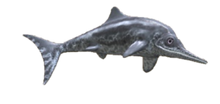| Ichthyosaurus Temporal range: Late Triassic - Early Jurassic | |
|---|---|

| |
| A restoration of Ichthyosaurus communis | |
| Scientific classification | |
| Kingdom: | Animalia |
| Phylum: | Chordata |
| Class: | Sauropsida |
| Order: | †Ichthyosauria |
| Family: | †Ichthyosauridae |
| Genus: | †Ichthyosaurus De la Beche & Conybeare, 1821 |
| Type species | |
| †Ichthyosaurus communis Conybeare, 1822 | |
| Referred species | |
Ichthyosaurus was a genus of ichthyosaur. Ichthyosaurus was a small variety of ichthyosaur, only reaching 2 meters (6.6 feet). They lived during the Late Triassic period to the Early Jurassic Period and ate small fish, squids, and other water-dwelling creatures. Ichthyosaurus lived in the seas that covered modern-day England. It was the first Jurassic Ichthyosaur.
Description[]
One may mistake Ichthyosaurus as the Jurassic equivalent of a bluefin tuna: this marine reptile had an amazingly fishlike shape, with a streamlined body, a finlike structure on its back, and a hydrodynamic, two-pronged tail.
One odd feature of Ichthyosaurus is that it possessed thick, massive ear bones, which might have conveyed subtle vibrations in the surrounding water to this reptile's inner ear (an adaptation that doubtless aided Ichthyosaurus in locating fish). Also, because specimens of Ichthyosaurus have been found with tiny, baby fossils nestled inside, it's believed that this marine reptile didn't lay eggs like other reptiles, but gave birth to live young.
As you may have guessed from its name, Ichthyosaurus has lent its name to an important family of marine reptiles, the Ichthyosaurus, which descended from terrestrial reptiles that ventured into the water during the late Triassic period. Before they faded from the scene (supplanted by better adapted plesiosaurs and pliosaurs), in the late Jurassic period, the ichthyosaurs produced some truly massive genera, most notably the 30-foot-long, 50-ton Shonisaurus.
Paleobiology[]
Ichthyosaurus was smaller than most of its relatives, measuring 2 meters (6.6 feet) in length. Hundreds of well-preserved, fossilized skeletons have been found in Jurassic rock at Holzmaden, Germany. Some of the bones were still articulated. Some fossils still had baby specimens inside them, indicating that Ichthyosaurus was viviparous. Similar finds in the related Stenopterygius also show this. The German fossils also featured the outline of Ichthyosaurus's skin, revealing that it had a fleshy dorsal fin on its back and a large caudal fin. Other ichthyosaur fossils showed this feature was not limited to Ichthyosaurus.
Ichthyosaurus ear bones were solid, probably transferring water vibrations to the inner ear. Still, hunting by sight was the creature's main feeding activity; it had huge, sensitive eyes, protected by bony shields. Coprolites of Ichthyosaurus reveal that its diet consisted of fish and squid. It was initially believed that Ichthyosaurus laid eggs on land, but fossil evidence shows that in fact the females gave birth to live young. As such, they were well-adapted to life as fully pelagic organisms (i.e. they never came onto land). The babies were born tail first to prevent them from drowning in the water.
First Fossil Discoveries[]

A small fossil of this marine repile was found by local sisters of Lyme Regis, one of the best places in the world for prehistoric fauna.
The very first Ichthyosaur fossil to be found was by Mary Anning and her brother Joseph Anning in 1811 when Mary was only just twelve. Joseph found the fossil skull in Lyme Regis, Dorset and Mary found the rest of the skeleton a few months later. Henry Hoste Henley of Sandringham, Norfolk, who was lord of the manor of Colway, near Lyme Regis, paid the family about £23 for it, and in turn sold it to William Bullock, a well-known collector who displayed it at London. There; it generated considerable interest, because at the time when most people in England still believed in the Biblical account of creation, which implied that the earth was barely a few thousand years old, it raised questions about the history of living things and of the earth itself. It was sold at auction in May 1819 as "Crocodile in a Fossil State" to Charles Konig, of the British Museum, who had already suggested the name Ichthyosaurus for it, for £45 and five shillings.
In The Media[]
- The Ichthyosaurus is one of the tameable creatures in ARK: Survival Evolved.
- Ichthyosaurus appeared on Dinosaur Train, one male individual named Igor.
- Ichthyosaurus appeared in Jurassic Park arcade.
References[]
- https://scitechdaily.com/scientists-discover-fish-like-marine-reptile-buried-in-its-own-blubber-150-million-years-ago/
- https://www.britannica.com/animal/ichthyosaur
- https://kids.britannica.com/kids/article/Ichthyosaurus/390067
- https://www.thoughtco.com/ichthyosaurus-1091502
- https://ucmp.berkeley.edu/diapsids/ichthyosauria.html
- https://www.mindat.org/taxon-7682338.html
- https://kidadl.com/dinosaur-facts/ichthyosaurus-facts
- https://oumnh.ox.ac.uk/learn-mary-annings-ichthyosaur
- https://www.livescience.com/43344-ichthyosaur-fossil-live-birth-found.html
- https://www.newscientist.com/article/dn26975-stunning-fossils-mother-giving-birth/